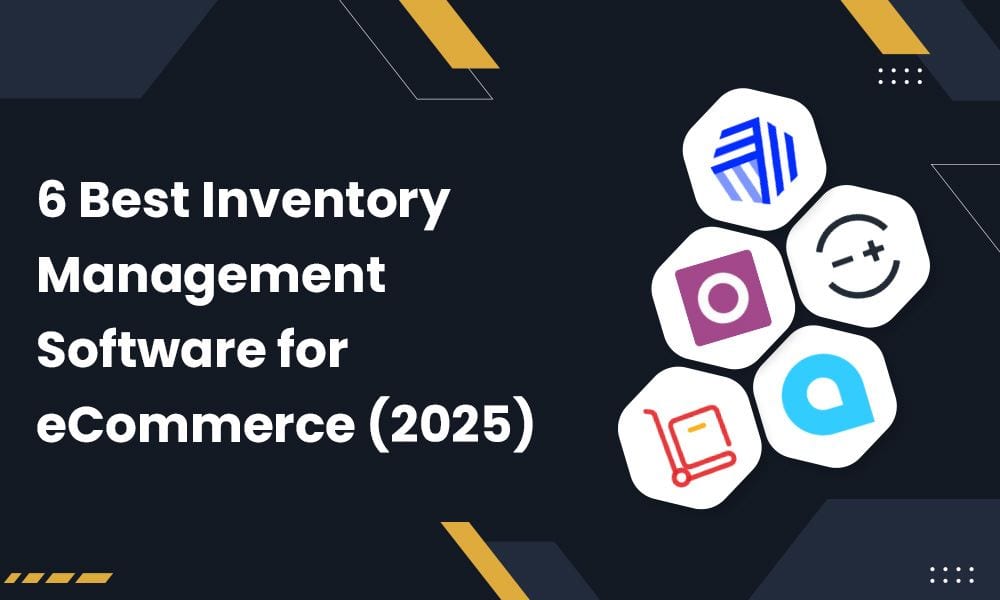Where would your eCommerce business be without inventory management software? Without it, you’d likely end up overspending and losing money fast.
According to inventory resource Netstock, reducing overstocks and stockouts can help businesses cut inventory costs by up to 10 percent.
Pretty cool, huh? And that’s only the tip of the iceberg. The right software can streamline your day-to-day operations while saving you money in other areas.
I’m sure you’re eager to learn more about inventory management software, right? Well, you’ve come to the right place. This guide will first explain the ins and outs of this software, then present the top options on the market in 2025.
Let’s get right into it.
Table of Contents
Key Takeaways
- eCommerce inventory management software is critical for maintaining inventory levels and avoiding overstocked supply and stockouts.
- Choosing the right inventory management tool requires knowing your budget and inventorying needs.
- Investing in effective inventorying software now and produce potentially higher ROI later.
Understanding Inventory Management Software
First, here’s your primer on inventory management tools and software.
As the name alludes, you’d use this software to manage your eCommerce inventory levels. Of course, it goes a lot deeper than that. For instance, you can also track which orders have come through, which have yet to be fulfilled, which are delivered, and your ongoing sales.
You could even delve into manufacturing processes with some inventory management software solutions, handling tasks like bills of materials or work orders.
For even greater efficiency, many businesses opt for ERP eCommerce integration, which connects inventory management with broader business operations like accounting, procurement, and customer relationship management (CRM).
The main benefit of investing in inventory management is ensuring you have the appropriate amount of stock to fulfill orders. You don’t want to be understocked, as then you’re sold out and miss out on revenue.
It’s equally as detrimental to experience too many overstocks, where you have too much supply that doesn’t move. The stock takes up valuable space in the warehouse, leaving you with less room for the supply that actually sells.
Implementing inventory management into your eCommerce processes can pay back dividends in these areas:
- Cost savings: The right inventory management software helps avoid common issues like overstocking and understocking. This not only streamlines your revenue processes but also allows your business to keep overheads in check. Beyond financial benefits, optimizing your team’s productivity is equally important.
- Enhanced productivity: With real-time tracking of inventory and order progress, your staff can focus on high-priority tasks that directly impact your business, eliminating inefficiencies. With time saved, accurate inventory tracking ensures precision in stock management.
- Accurate inventory tracking: A comprehensive inventorying solution provides real-time insights into stock levels, helping you move the right orders forward without delays and ensuring your stock management is always precise. Efficient stock management leads to better warehouse organization.
- Organized warehouse: With inventory management, your stock moves through the warehouse smoothly, freeing up valuable space and ensuring popular items are always available for your customers. Ultimately, these improvements culminate in a better customer experience.
- Happier customers: When customers receive their orders promptly and without issues, it leads to a more satisfying experience. Using a reliable inventory management tool ensures timely delivery, which consistently exceeds customer expectations.
Typical features
Great. So, what kinds of features are included in eCommerce inventory management software? Well, of course, it varies depending on the tool, but here are some standard features you should expect to see.
Inventory levels
What do you have, and how much of it is there? You can track your inventory levels at a glance, so you always get what you need.
Order quantities
The order quantities feature indicates when to reorder some units, including how many. This information comes courtesy of your level of stock and the reorder point. However, more than managing orders alone is required with barcode tracking.
Barcode scanning
Barcodes help warehouse employees make heads or tails of incoming and outgoing orders. Some inventory management tools include built-in barcode scanning to track the product’s journey, from leaving the warehouse to delivery to the customer’s door.
Besides that, barcode scanning features can help you obtain supplier information, SKU data, and physical dimensions. This helps manage inventory effectively. Additionally, understanding stock levels is vital for planning.
Stock cover
Stock cover is an excellent feature to have in any inventory management software worth its salt. This feature indicates how many days it will take until a stockout occurs unless you reorder the required materials. You can prioritize what to reorder and when.
Lead demand
Calculating the efficiency of your lead time begins with knowing the lead demand. This indicates how many units you’ll sell in a lead time period. This, combined with automated reorder points, keeps stock flowing.
Reorder point
Many inventory management programs feature reorder point or ROP functionality. Also known as the reorder level, this feature will automatically trigger once your inventory reaches a certain level.
ROP is determined by adding the safety stock to the replenishment lead time as a percentage.
Shipment tracking
You should also expect to see a shipment tracking feature that gauges where the shipments are after they’re sent to your customers. You don’t want orders to get lost in transit, and with this feature, you can minimize unwanted disruptions. Delivery tracking software helps eCommerce businesses streamline inventory management, improve order accuracy, and provide real-time shipment visibility, ensuring enhanced customer satisfaction and efficient operations across the entire fulfillment process.
If an order does get lost or experiences delays, you’ll have a clearer idea of where it is so you can keep the customer in the loop, helping maintain customer relations. Besides tracking shipments, managing supplier relationships is crucial to ensure inventory levels stay consistent and costs are controlled, ultimately ensuring the smooth functioning of your supply chain.
Supplier management
It takes a lot of moving parts to bring eCommerce orders to fruition. Supplier management features make it easy to track your suppliers at a glance. You can compare rates and estimates in real-time, ensuring you get the best value.
Inventory reports
Finally, inventory management software will include inventory reporting. You can track all the metrics and data the program has produced over a specific period, such as your inventory levels, activity, inventory details, purchase trends, and sales rate.
Read more: Effective Inventory Management for Small Business Success
6 Top eCommerce Inventory Management Software for 2025
Are you ready to explore the best inventory management tools out there? I’ve compiled a list of the best tools for eCommerce brands of all sizes. I’ll include pros, cons, and comparisons of features to help you make a confident purchasing decision.
Cin7

- Pros: Task automation to save time, real-time tracking of the metrics that matter
- Cons: This software is a touch tough to use at first and doesn’t provide much support
- Best for: Businesses interested in batch tracking and detailed reporting
A cloud-based software created in 2002, Cin7 is for multichannel inventory management made easy. It has solutions designed for all business areas, from accounting to payments, advanced manufacturing, automation, and more.
Features
- Batch and expiration tracking: Never wonder what will expire and when, thanks to expiration tracking. You can now handle recalls with aplomb, even if you must deal with large batches simultaneously.
- Single products or custom kits: If you sell the types of products customers buy individually, Cin7 has one-by-one packaging. They also offer curated collection packaging in custom kits to accommodate customers’ shopping behaviors.
- Automated, synced data: Cin7 updates in real-time to ensure reduced instances of stockouts. You’ll always know what’s happening with your inventory around the clock.
- Add new inventory: When an incoming order arrives, you can be ready to handle it, thanks to Cin7. Update your warehouse inventory as it comes in, and then get the order ready to ship out to the customer.
- Warehouse management: Once your inventory management is under control with Cin7, you can use its myriad features to transform your day-to-day warehouse operations.
- Automation: Controlling inventory is a breeze, in part thanks to the fact that Cin7 has many automatable features.
- Forecasting and reporting: Cin7 does more than prepare basic reports. You can request customizable reports focused on cashflows or current inventory levels. Once you accumulate historical data, Cin7 can produce future forecasts.
Pricing
Are you considering Cin7 for your inventory management needs? You can choose from four pricing plans.
The Standard plan is $349 a month and includes five users, two eCommerce and app integrations, and a sales order volume of 6,000 per year.
The more comprehensive Pro plan for $599 per month allows access for ten users, four eCommerce and app integrations, and up to 24,000 sales per order volume a year.
Consider the Advanced plan for $999 a month if you want even more features than what the Pro plan has to offer. You can add automation, increase your user base to 15 people, use six eCommerce and app integrations, and have a sales order volume of 120,000 per year.
There’s also an Omni plan with custom pricing designed for multi-channel, fully integrated product sellers.
Linnworks
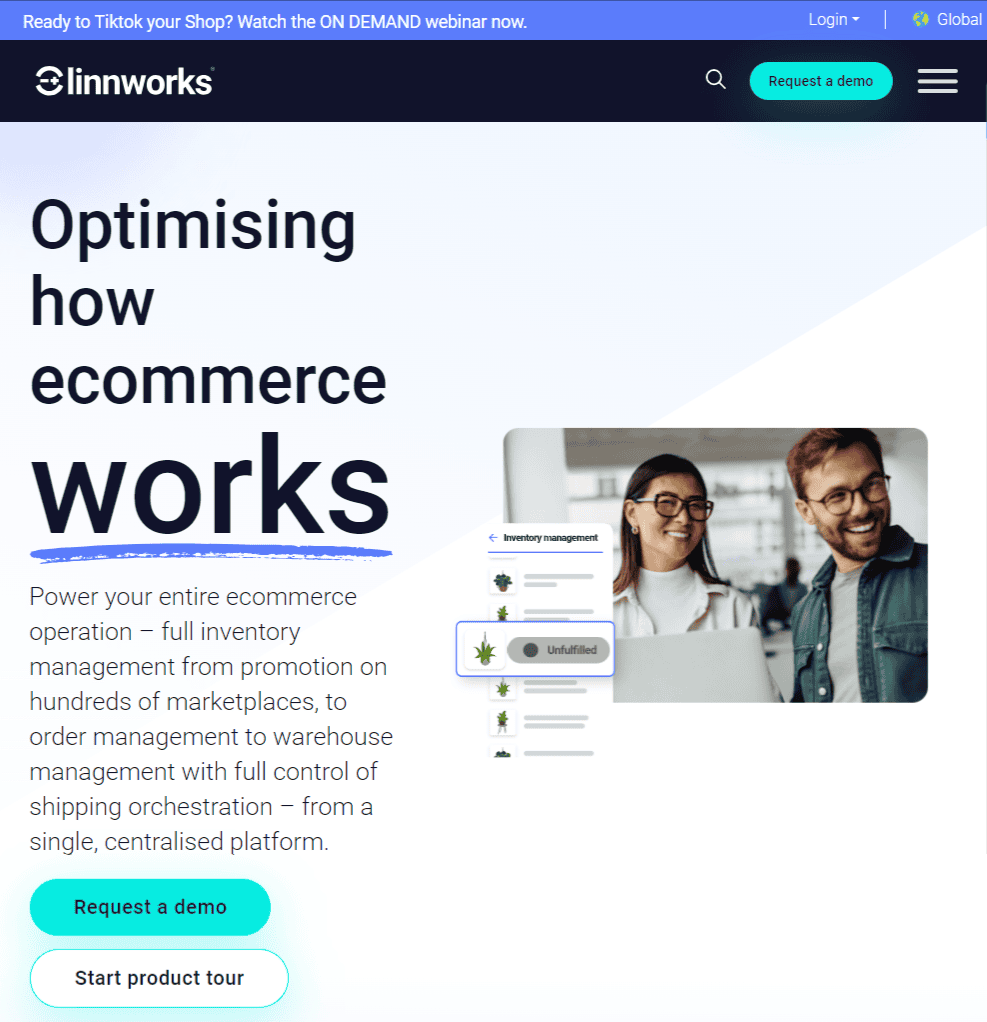
- Pros: Offers predictive insights for futureproofing and provides multichannel listings to expedite processes
- Cons: The pricing could be more transparent
- Best for: Businesses seeking sales synchronization across platforms
Next, there’s Linnworks, an order management and eCommerce inventory software catered toward business growth through cost reduction and automation. Its product best serves eCommerce sellers, Amazon FBA participants, 3PLs, multiproduct sellers, and eCommerce sellers.
Features
- Inventory management: With real-time updates for inventory levels across your bin locations and warehouses, Linnworks ensures you’ll never miss a beat. You can sync all channels automatically to keep your data current and even use Linnworks for demand forecasting. Apart from tracking inventory, managing your orders is equally crucial.
- Order management: How much time do you waste managing orders? It’s time to use Linnworks’ order management automation, which has picking, packing, and dispatching features. You can modify your automation workflows anytime to suit your needs. The order management tool also provides data, such as order volumes and your biggest sellers.
- Warehouse management: Keep your warehouses ready to rock ‘n’ roll with warehouse management tools from Linnworks. Manage inventory as it comes and goes, automate the most time-consuming tasks, and streamline other processes.
- Enhanced Warehouses: Take your warehouse a step further using the Enhanced Warehouse collection of features from Linnworks. You can access Kits to package related items in one order and increase order value or try Wavepicking to gather orders. The Lots feature is designed to get soon-to-be-expired items out of the warehouse.
- Multichannel listings: Open up more sales channels; you can handle them using multichannel listings within Linnworks. All your sales listings will be on one dashboard so you can track inventory levels, ongoing sales, delivery progress, and more.
- Shipping management: Linnworks has more than 70 shipping integrations at your fingertips through its inventory management software. You can build a shipping network that suits your eCommerce business and then automate it.
- Forecasting and reporting: Obtain more of the data that matters to you by requesting tailored reports and forecasts to see where your business will go next.
- Integrations: Linnworks has a laundry list of integrations it offers, with some of its partners including such major names as:
- Amazon
- BigCommerce
- eBay
- Katana
- Intuit QuickBooks
- ShipBob
- Payoneer
Now that you understand the features, let’s explore the pricing plans.
Pricing
As I said, the pricing could be more transparent if you’re considering using Linnworks. It offers two pricing tiers: Core or Advanced. You can pay for add-ons from there.
The Core version of Linnworks includes:
- API
- Native integrations
- Quality control
- Stock forecasting
- Warehouse reporting
- Purchase order management
- Product catalogs
- Inventory management
You can pay for an Enhanced Warehouse add-on with 3PL, Wavepicking, serialization, lots, and kits and bundles. Another add-on for this plan is Order Management. That includes catalog management, centralized order management, inventory and warehouse syncing, and automated order routing.
The Advanced plan offers these features:
- All native Linnworks integrations
- Unlimited routing rules
- Advanced Order Management Suite
- API Access
- Reporting
- Shipping management
- Purchase orders
- Cataloging
You can select from Forecasting, WMS, or Listing add-ons, the latter of which includes multiple channel listings and revisions.
Odoo
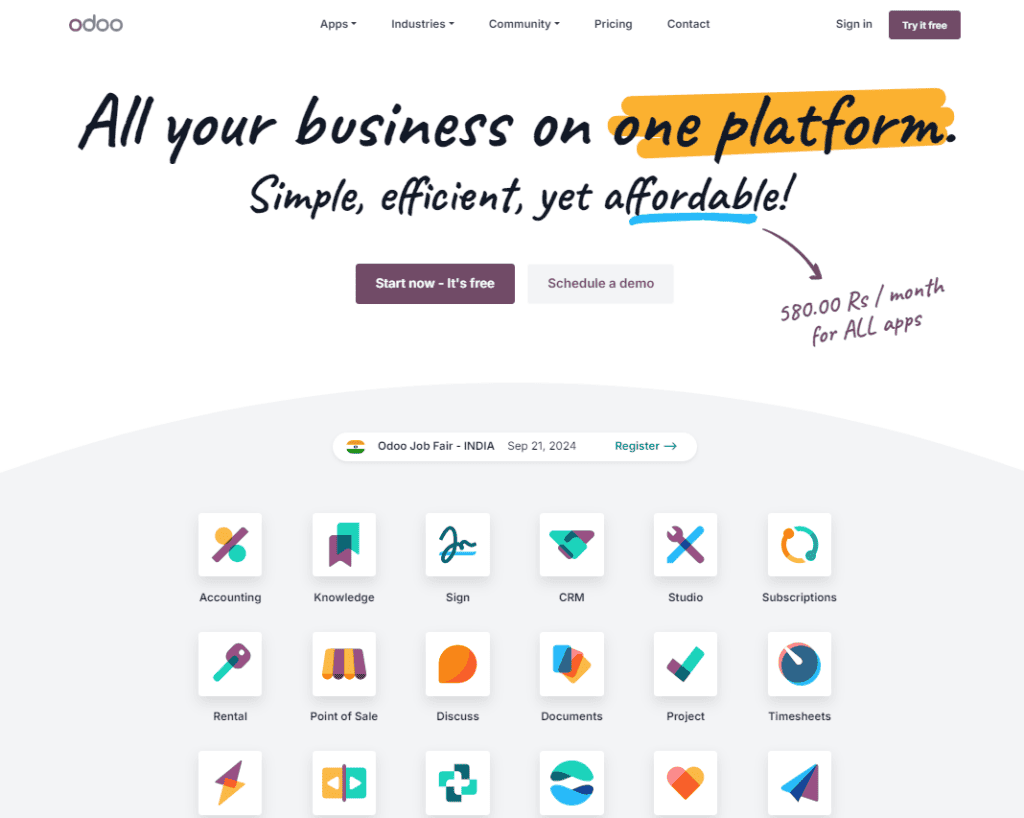
- Pros: A flexible tool that provides a comprehensive suite of products with real-time updates
- Cons: Setting up Odoo can be difficult, and its learning curve is rather steep, especially for customization
- Best for: Companies seeking a business management suite
The Belgian-based Odoo is an open-sourced single-platform service that includes CRM, website building, supply chain tools, finance services, sales features, HR tools, productivity features, and marketing products.
Its supply chain features are what will be of most interest to you as an eCommerce business owner. Here, you can access features such as inventory management, purchase tracking, and quality assurance.
Features
- Smart replenishments: Use a master production schedule or min-max rules to determine when it’s time to replenish your supply. Odoo can launch reorders automatically or send specific triggers you can use to manually re-up your units.
- Shipment control: Odoo puts the power of shipping control in your hands. You can implement customizable routes, codes, or rules to ensure shipments go out on time. You can also rely on Odoo for put-away strategies, including cross-docking, ABC analyses, and slow-fast movers.
- Inventory management: Track your warehouses with Odoo, which includes all the features you need for management, from cycle counting to reservation strategies, packaging, lots, and serial numbers.
- Multiple picking options: Even though you can’t be in all your warehouses at the same time, you can still feel like you can. Odoo gives you several picking strategies to implement per warehouse, from batch to wave, cluster, and single picking.
- Carrier integrations: Odoo works with all your favorite carriers, ensuring you can pack units from pallets to boxes and get shipping labels slapped on while maintaining your high standards for quality control.
- Barcode scanning: Barcodes are available online and off. You can use GS-1, QR, or barcode scanning.
- Automation: Save more time by simplifying complex tasks and routes within Odoo. You can win back time, reduce instances of mistakes, and improve productivity. Apart from automating tasks, maintaining accurate valuations is also key.
- Inventory valuations: You can always ensure the top value for your inventory between options like standard price, LIFO, average price, and FIFO.
Pricing
Select from one of three pricing plans when using Odoo for your inventory management needs. All prices are listed under annual billing.
- The One App Free plan is $0 a month for unlimited users but only one app.
- If you want all apps, you must pay for at least the Standard plan, which is $24.90 per user per month.
- You can also opt for the Custom pricing plan for $37.40 per user per month, which adds on-premise services.
Zoho Inventory
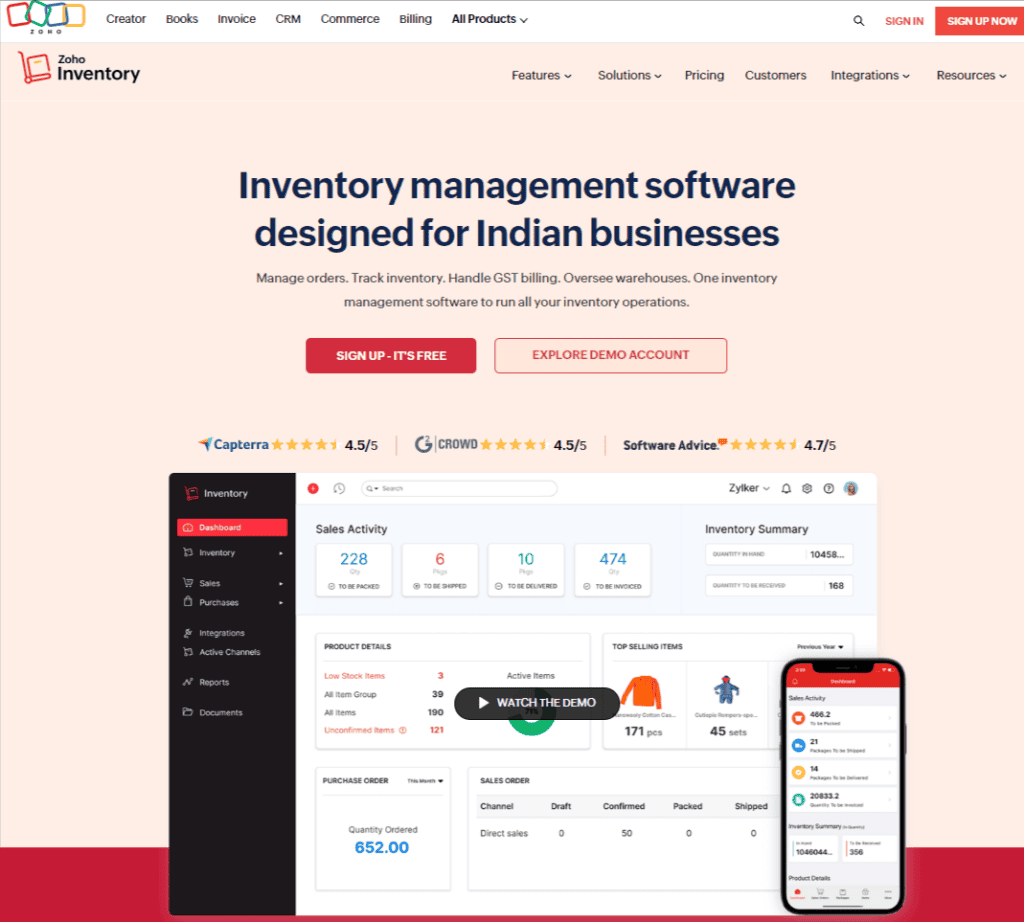
- Pros: Offers multi-channel capabilities, is easy to use, and cost-effective
- Cons: If you’re on a bigger team, you might find some of the features limiting
- Best for: You’re a business who wants to start managing inventory without overcoming a huge learning curve
Zoho is a cloud software suite with all sorts of business services, such as Zoho Inventory. Companies like Miller Industrial, Max Marine, and Alloygator trust Zoho Inventory to keep their customers happy. Your eCommerce business may do the same.
Features
- Cloud-based inventory management and control: All your inventory and warehouse data are available in the cloud when using Zoho Inventory, allowing you to pick it up across multiple devices or teams. Now, everyone can stay in the loop.
- Centralized inventory: Zoho Inventory will automatically update your inventory for each selling channel you use when you make a sale. You don’t have to worry about human error making your numbers screwy.
- Product listing data: Sort through your inventory anytime by criteria such as SKU, item availability, item cost, and more. If you use custom attributes, Zoho Inventory lets you make item variants per attribute.
- Item kits: You can group together related items to sell as one within Zoho Inventory, which will automatically update your inventory levels as your products sell.
- Automatic reorders: Who has time to manage when it’s time to reorder certain stock? Not you. You have enough on your plate. Fortunately, you can rely on Zoho Inventory’s automatic reorder feature. You can even select your ideal vendors and set reorder reminders.
- Stock adjustments: Product shrinkages don’t have to cause you grief anymore. With Zoho’s stock adjustments feature, you can prepare for such instances with fewer customer interruptions.
- Barcode inventory management: If you’ve built a barcode system within your eCommerce business, Zoho Inventory’s barcode inventory management is just what you need. You can scan barcodes and let Zoho fill in all the rest of the information. This feature is perfect for purchase orders, sales orders, and invoices.
- Order tracking: Use serial numbers or expiry dates to track priority orders and keep your customers happy.
- Reporting: Zoho Inventory offers an assortment of reports, including sales reports, FIFO tracking, purchase reports, and more. You can export any data to PDF, XLS, or CSV format quickly and efficiently.
Zoho inventory offers numerous features, but let’s take a look at its pricing structure.
Pricing
Zoho Inventory provides four pricing plans to select from, with monthly or yearly billing available. Here is the pricing for each plan with annual billing:
- The Standard plan costs $29 per company per month. You can add one warehouse, two users, and 500 monthly orders.
- Upgrade your needs by choosing the Professional plan for $79 per monthly company. This plan adds an extra warehouse, one extra user, and up to 3,000 orders a month.
- The Premium plan for $129 per company per month offers three warehouses, 2,000 bins per warehouse, two users, and 7,500 monthly orders.
- The most encompassing of the plans Zoho Inventory offers is the Enterprise plan for $249 per company per month. Under this plan, you get seven warehouses, 5,000 bins per warehouse, seven users, and 15,000 monthly orders.
Acumatica
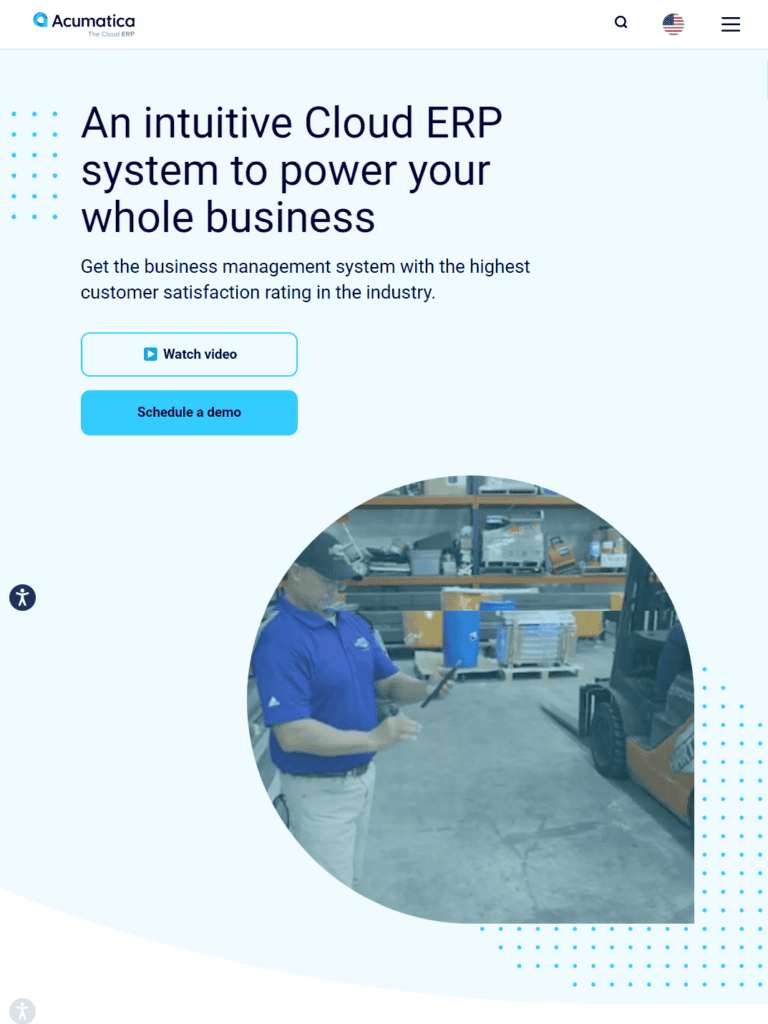
- Pros: Has strong integrations and lots of customization options
- Cons: However, like Odoo, customizing Acumatica is harder than it looks; its pricing is also very mysterious
- Best for: Businesses looking for a scalable license
Next, there’s Acumatica, a cloud-based eCommerce inventory management software. It’s designed for an assortment of industries besides eCommerce, including nonprofits, telecommunications, agriculture and farming, property management, transportation, and education.
Features
- Order management for items out of stock: When dealing with non-stock items, you need a tool such as Acumatica on your side. You can discount stock or offer flexible pricing to appease your customers.
- Suggested items: Maximize the value of each sale you make with product recommendations such as upselling and cross-selling.
- Sales orders: When you get sales orders or quotes for items you have in stock, use Acumatica’s order management tool. This function can also convert the quotes your customers approve into sales orders. If you use other commerce storefronts, Acumatica can synchronize everything onto its platform.
- Vendor performance analysis: It’s easier to select vendors when using Acumatica. You can compare their services, delivery times, prices, and products, then pick the right one. From there, Acumatica allows you to note the lead times, quantities, and costs when working with a vendor.
- Automation: Use the built-in integrated workflows, then set up alerts and notifications for status changes and more.
- Reporting: Between auditing reports and inquiry screens, you can feel confident that you’re taking your eCommerce business in the right direction using Acumatica.
Pricing
Acumatica charges depend on the apps you use, the license you select, and your data storage rate.
Extensiv
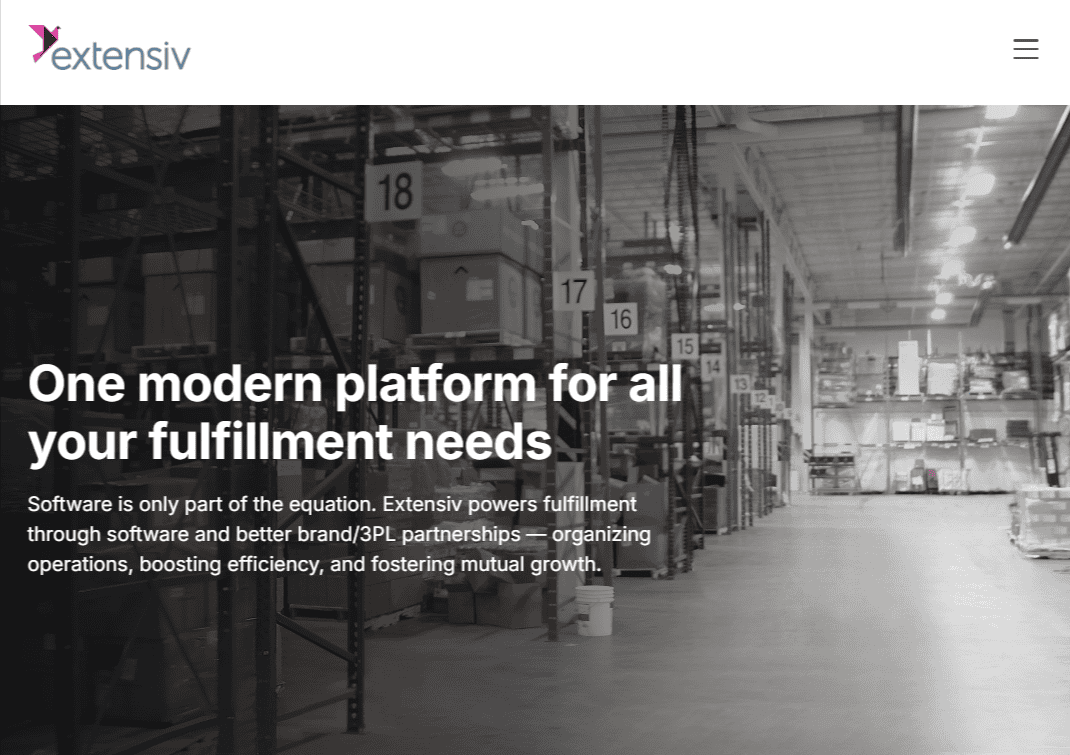
- Pros: Offers digital automation and multichannel management
- Cons: It’s a little complex, especially for newer businesses
- Best for: Businesses that identify as 3PLs
The omnichannel fulfillment tool Extensiv assists 3PLs and brands with omnichannel fulfillment by linking them with top-line fulfillment networks. Its ecosystem is full of partners and integrations designed to make eCommerce inventory management possible.
Features
- Warehouse management: Keep your warehouse activities within view using Extensiv. You can set up picking, packing, and shipping. Its warehouse management features also include real-time data access, auditing and managing inventory, and inventory receiving.
- Order management: Take charge of your eCommerce business using Extensiv’s order management feature. You can simplify order management through automation, replenish inventory before it turns down to nothing, integrate shipping, and even forecast product demand.
- Integration management: Extensiv provides a selection of integrations designed to streamline your day-to-day eCommerce processes.
With these features covered, let’s explore the pricing options offered by Extensiv.
Pricing
Extensiv offers four pricing plans to choose from. The first is Merchant for $39 per month, and your first month is free. The features include:
- Premium order sources for $30 a month
- Standard order sources for $15 a month
- No setup costs or contracts
- No user limits
- No order volumes
For more integrations and features, upgrade to the EDI Merchant plan for $99 a month. You can get the first month free. Besides everything above, you also get additional EDI order sources for only $79 a month.
Increase your integrations with the EPL plan, also for $99 a month with the first month free. This plan helps you avoid per-merchant fees.
The costliest plan is the Master Account for $199 per month. You can use everything above, plus:
- Unlimited fulfillment accounts
- Unlimited merchant accounts
- White-label options
Read more: CRM for Retail – Strategies and Software to Drive Up Loyalty
Choosing the Right Software for Your Business
You’ve just been introduced to six excellent eCommerce inventory management software options. Now, it’s time to choose the right one for your business, whether you’re still in the startup stage or more established.
Here are some factors you need to weigh.
Business size
Even though your business may be on the smaller side now, that won’t always be the case. That’s why it’s best to be future-minded when selecting an inventory management tool. You can usually begin with a more inexpensive plan at the startup stages, saving money until you grow. Then, you can expand to a costlier plan. As your business grows, your needs may change, which brings us to the next factor.
Number of channels
Do you use only a single inventory channel or several? Almost all the inventory management tools from the last section support several channels and warehouses, so you can wholly embrace growth. As you scale further, more channels can drive growth and efficiency.
Sales volume
You should still use some inventory management tools if you don’t have a high sales volume, but more criteria’ll bind you. For instance, you’ll need something cost-effective, which will rule out the pricier software we examined in the last section. Once you consider your sales volume, evaluating the software’s ability to scale with your growth is crucial.
Scalability
Scalability is one of the biggest features to consider as you compare your software options. Inventory management software must be designed to grow with your business, no matter its size, supporting the next steps in your professional development.
Many companies also hire developers in India to build scalable, custom inventory solutions tailored to evolving business needs.
Integration with existing systems
Lastly, you should carefully consider how much the inventory management software integrates with the processes and tools your eCommerce business already relies on. If you don’t have enough integrations, it can become annoying and time-prohibitive to have to use so many tools.
Innovative Features in Inventory Management
While today’s inventory management software already has many great features for eCommerce businesses eager to optimize, there are yet more forward paths to innovation I find very interesting. They include the following:
Real-time tracking
Inventory can change in an instant. You need to be ready for when it happens so you can proactively respond, and that’s what real-time tracking achieves. You can even prevent stockouts with this feature.
Automated reordering
Automated reordering schedules when you’ll get new stock and lets it all happen without your intervention, keeping your supply chain steady.
Multi-warehouse management
Growth means adding to the number of warehouses you use. More and more inventory management software options support multiple warehouses, so you can keep everything operational even when you can’t be there.
Emerging trends
Of course, one can’t gloss over these future inventory management software trends that prove the future is closer than we might think!
Predictive stock adjustments
In the future, predictive stock adjustments can help you plan for reduced stock and customer demand. You won’t purchase more stock than required, ensuring you don’t have to worry about overstock.
AI-driven analytics
AI is also shaping the future of inventory management. AI can parse your existing customer and sales data and then make recommendations for future sales, stock levels, and more.
Read more: eCommerce Automation – How to Automate Your eCommerce Business
Maximizing Your Inventory Management Setup
You’ve chosen the right inventory management software for you. Now, it’s time to begin using it. These pointers will help you do just that.
Take advantage of free trials
Free trials help you preview the program before committing your hard-earned money. Use them! Try all the available features. Make a note of the ones you have a hard time with. Also, record those you use that could benefit your eCommerce business most.
Trials are a great way to compare software options directly until you find the easiest one.
Watch all videos and demos
Why do software companies make so many videos? You can view them, of course. Set aside some time for software demonstrations, video tutorials, and other resources put together for you. Read the knowledge base or FAQs if the company has them.
You never know. If your question is common enough, the answer could be right there on the company website.
Read integration instructions carefully
Syncing two software solutions doesn’t have to be tough, but if you make a mistake, you’ll waste a lot of time. Review the instructions for implementing an integration and follow them to the letter. That will ensure it goes smoothly.
Get comfortable with support
It’s a good idea to know how responsive the support is sooner than later. If it takes them forever to get back to you while you’re still trialing the product, you’ll know better than to invest in a long-term deal.
Train your team
One of the biggest pitfalls when using new business software is foregoing team training. Your employees will have to learn how to use the inventory management software, as will your vendors and business partners in other warehouses.
Provide online training sessions at various times that your team can partake in. This way, everyone can learn at times that suit their schedules.
Read more: How to Build an Automated Dropshipping Business
Conclusion
Inventory management software for eCommerce businesses can transform how you serve customers by reducing errors and expediting processes. However, you must evaluate your specific needs when choosing software, using demos or trials.
Leveraging technology to enhance customer satisfaction and inventory accuracy will drive your business forward, so choosing the right software for later is worth it now.
EngageBay is an all-in-one marketing, sales, and customer support software for small businesses, startups, and solopreneurs. You get email marketing, marketing automation, landing page and email templates, segmentation and personalization, sales pipelines, live chat, and more.
Sign up for free with EngageBay or book a demo with our experts.
FAQ
What is the best inventory management software for small eCommerce businesses?
That depends on what you’re looking for, specifically in inventory management software. At the very least, you should choose software that offers scalability, customizable features, and automation to save time and reduce human error.
How does inventory management software integrate with other eCommerce platforms?
You can integrate eCommerce platforms with inventory management software by syncing them together. You can then get an all-in-one view of your ongoing orders, stock, and rate of deliveries.
Can inventory management software help reduce costs for my business?
Absolutely! You can reduce overstocks and stockouts, both of which will shave down your unnecessary expenses. Further, you’ll have fewer aggravated customers.
What are common challenges faced when implementing inventory management software?
Using inventory management software can lead to a few frustrating challenges, such as:
- An upward learning curve that makes using the software difficult.
- Poor support leaves your questions unanswered.
- Tools that don’t update in real-time, thus causing you to act on outdated information.
These issues prove why doing your due diligence before investing in software is so valuable.
How can I ensure my inventory data is secure with this software?
The software should offer a privacy policy so you understand how your data is used and by whom.
